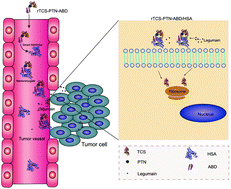Genetically-engineered protein prodrug-like nanoconjugates for tumor-targeting biomimetic delivery via a SHEATH strategy†
Abstract
The delivery issue is a major hurdle against drug development and the clinical application of the cytoplasmic active proteins (e.g., ribosome-inactivating proteins, RIPs). As a case in point, trichosanthin (TCS) has a very high cytoplasmic activity of killing cancer cells, but the translation is hampered by its unfavorable nature, such as the short half-life, poor tumor targeting and cell permeation. To address this issue, a novel delivery method called a smart hitchhike via endogenous albumin-trichosanthin hinge (SHEATH) system was developed by the genetic fusion of an albumin-binding domain (ABD) and a legumain-substrate peptide to TCS. The SHEATH system is characterized by the feature of smart hitchhike by binding to serum albumin via its ABD domain, and the two proteins (i.e., TCS and albumin) thus form a prodrug-like noncovalent nanoconjugate. The TCS could detach from the albumin carrier by responding to the protease legumain cleavage of the substrate peptide at the tumor site. Such a system can take advantage of the albumin-mediated biomimetic delivery to the tumor via the nutrient transporter pathway of albumin-binding proteins (e.g., SPARC). The antitumor effects were evaluated in orthotopic breast cancer animal models and showed remarkably improved antitumor effects. Our work provides a useful protocol for improving the druggability of such a class of protein toxins for targeted cancer therapy by an endogenous albumin-hitchhike strategy.



 Please wait while we load your content...
Please wait while we load your content...